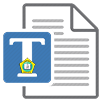Kemampuan Literasi Sains Mahasiswa PGSD Universitas PGRI Adi Buana Surabaya
Abstract
Full Text:
PDFReferences
Asyhari, A. 2017. Literasi sains berbasis nilai-nilai islam dan budaya Indonesia. Jurnal Ilmiah Pendidikan Fisika Al-BiRuNi, 06 (1) (2017). DOI 10.24042/jpifalbiruni.v6i1.1584
Bybee, R. W. 2009. PISA’S 2006. Measurement of Scientific Literacy: An Insider’s Perspective for the USA. Presentation for the NCES PISA Research Conference. Washington: Science Forum and Science Expert Group.
Bybee, R.W. 1997. Toward an understanding of scientific literacy. In: W. Gräber & C. Bolte (Eds.). Scientific literacy: An international symposium (pp. 37-68). Kiel, Germany: IPN.
Dani, D., 2009. Scientific Literacy and Purposes for Teaching Science: A Case Study of lebanese Private School Teachers. Special Issue On Scientific Literacy (Editors richard K. Coll & Neil Taylor). International Journal of Environmental & Science Education. Vol. 4(3),pp.289-299.
Kemendikbud. 2016. Peringkat dan Capaian PISA Indonesia Mengalami Peningkatan. https://www.kemdikbud.go.id/main/blog/2016/12/peringkat-dan-capaian-pisa-indonesia-mengalami-peningkatan. Diakses tanggal 30 April 2019 pukul 09.59.
Nofiana, M. & Julianto, T. 2018. Upaya Peningkatan Literasi Sains Siswa Melalui Pembelajaran Berbasis Keunggulan Lokal. Biosfer Jurnal Tadris Pendidikan Biologi Vol. 9 (1), 2018.
OCED. 2009. PISA 2009 Assessment framework: Key Competencies in reading, Mathematic, and Science. Paris: OECD publishing.
Odja, A. H. & Payu, C. S. 2014. Analisis Kemampuan Awal Literasi Sains Siswa Pada Konsep IPA. Prosiding Seminar Nasional Kimia. Jurusan Kimia FMIPA Universitas Negeri Surabaya.
OECD. 2013. Results PISA 2012 Assessment FrameworkKey Competencies In Reading,mathematics and science. OECD.
Rahmania, S., Miarsyah, M. & Sartono, N. 2015. Perbedaan Kemampuan Literasi Sains Siswa dengan Gaya Kognitif Field Independent dan field Depdendent. Biosfer Jurnal Tadris Pendidikan Biologi Vol 8 (2), 2015.
Shofiyah, N. 2015.Deskripsi Literasi Sains Awal Mahasiswa Pendidikan IPA Pada Konsep IPA.Journal Pedagogia. Volume. 4, No. 2, Agustus 2015.
PISA. 2010. Assesing framework key competencies in reading, mathematics, andscience. OECD Publishing.
Soobard, R., & Rannikmäe, M. 2011. Assessing student’s level of scientific literacy using interdisciplinary scenarios. Science Education International, 133-144 .
DOI: http://dx.doi.org/10.30742/tpd.v1i01.668
Refbacks
- There are currently no refbacks.
Copyright (c) 2019 Trapsila: Jurnal Pendidikan Dasar
RECOMMENDED TOOLS:
Supported by:
Trapsila Journal is licensed under Creative Commons Attribution-ShareAlike 4.0 International License







